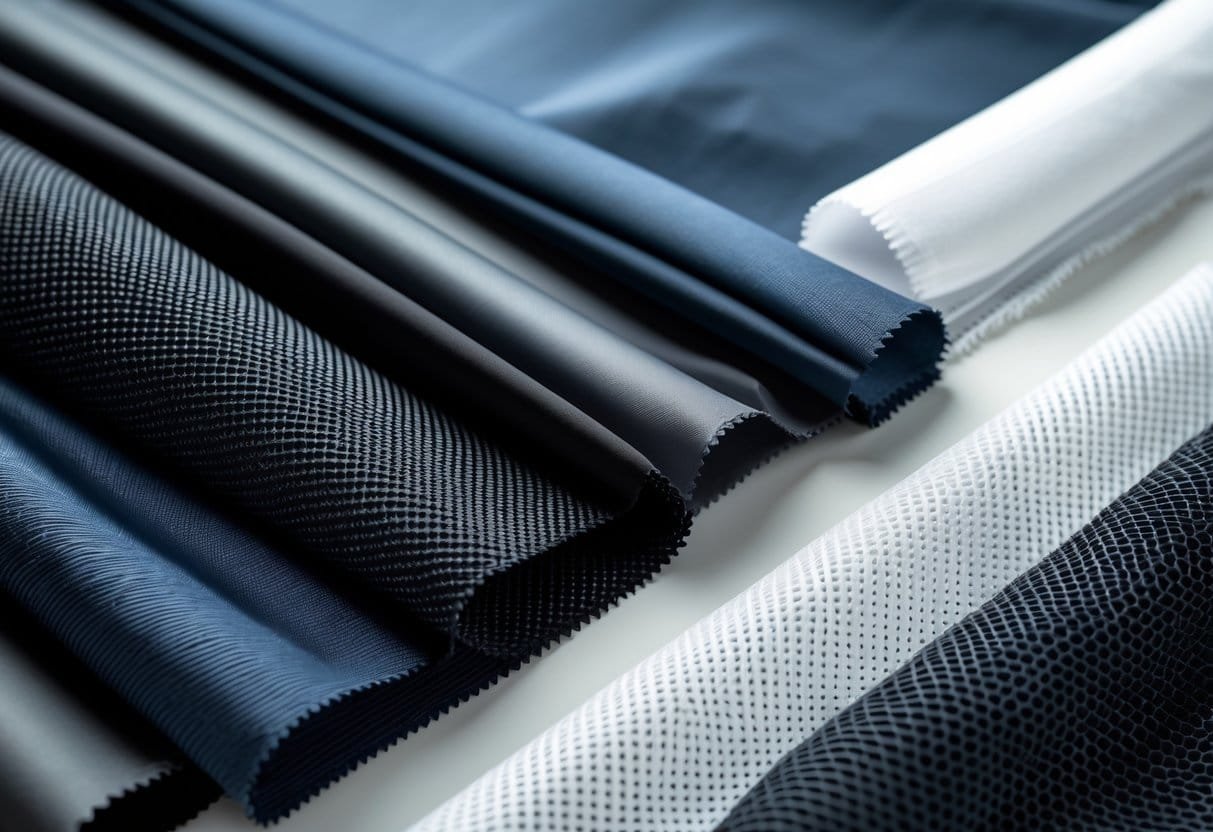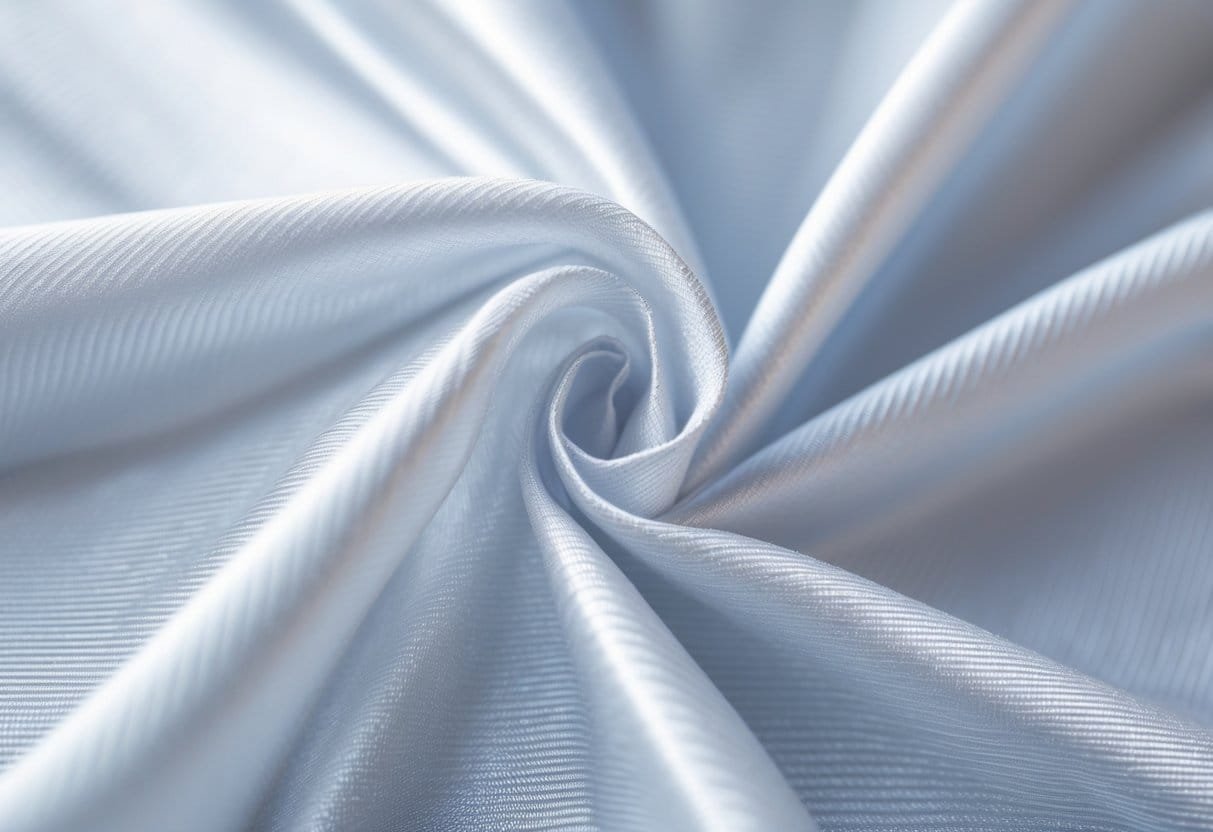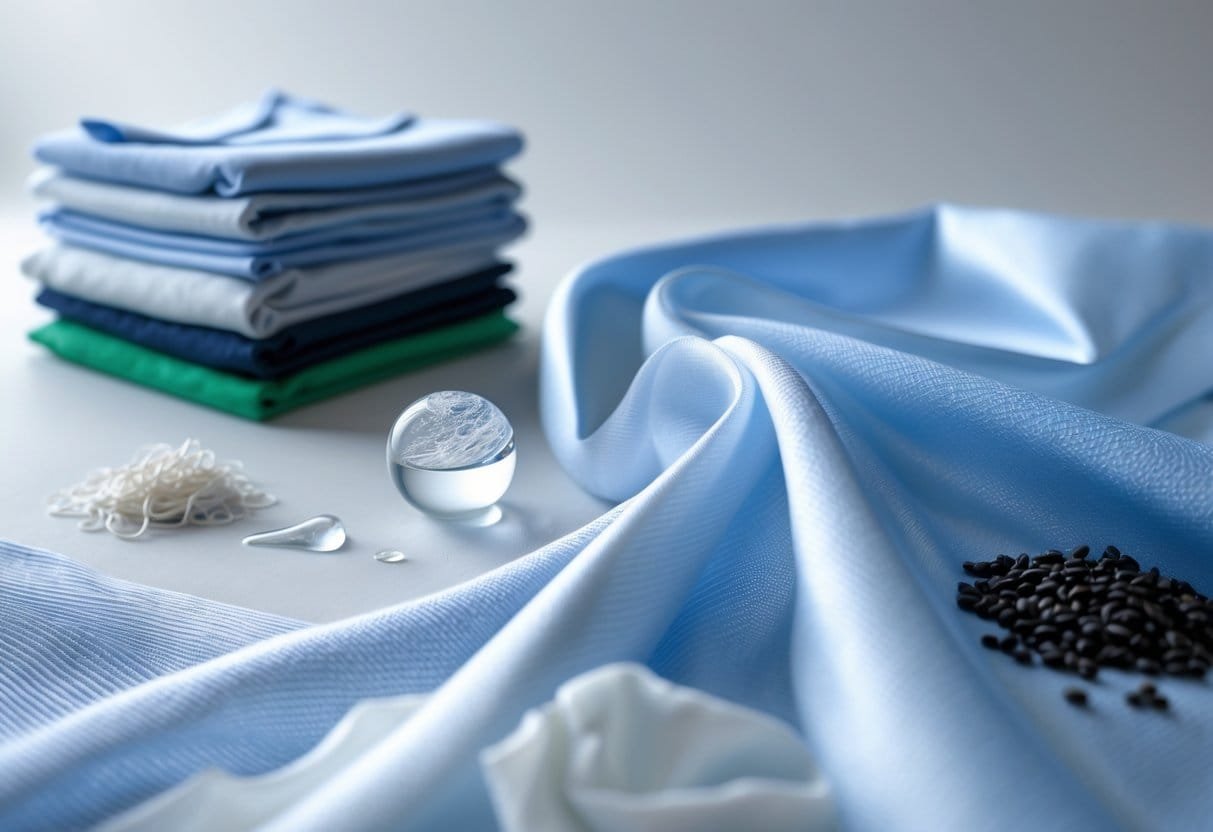Nylon Fabric: A Complete Guide to Features, Uses & Benefits
Nylon fabric is a man-made textile known for its strength, flexibility, and durability. It was first introduced in the 1930s and quickly changed the way materials were made and used. Its combination of lightweight feel and toughness makes nylon a popular choice across many industries.

This synthetic fabric is used in everything from clothing and sportswear to industrial products like ropes and car parts. It also stands out for being easy to care for and resistant to damage from wear and moisture. Understanding nylon’s properties helps people choose the right fabric for their needs and care for it properly.
Nylon comes in several types, each suited for different purposes. This variety adds to nylon’s wide range of uses, making it a fabric that combines performance with versatility. Knowing the key facts about nylon can benefit both consumers and professionals alike.
Key Takeaways
- Nylon is a strong and flexible synthetic fabric used in many products.
- It offers durability and easy maintenance for various applications.
- Different types of nylon serve different needs across industries.
What Is Nylon Fabric?

Nylon fabric is a man-made material known for its strength, elasticity, and durability. It is made through a chemical process that produces long polymer chains, giving the fabric its unique properties. Unlike natural fibers, nylon offers specific advantages in performance and resistance to wear.
Definition and Origin
Nylon is a synthetic fabric created from polyamide fibers. It was first developed in the 1930s by Wallace Carothers and his team at DuPont. It was the first synthetic fiber to be produced on a commercial scale. This invention marked a major shift in textiles by offering a strong, lightweight alternative to natural fibers like silk.
The initial goal was to create a fabric that could replace silk in products such as stockings. Since then, nylon has been used in various industries beyond fashion, including outdoor gear, sportswear, and industrial products.
Synthetic Polymer Structure
Nylon fabric is made from long chains of polyamide molecules. These chains are formed through polymerization, a process that links smaller chemical units into large molecules. The fibers are created by melting nylon polymer and forcing it through spinnerets to form continuous filaments.
This molecular structure gives nylon its high strength, elasticity, and resistance to stretching or breaking. Nylon fibers can be woven or knitted to create different textures. The smooth surface of the fibers also adds a slight shine to the fabric.
How Nylon Differs from Natural Fibers
Nylon is fully synthetic and differs greatly from natural fibers like cotton, wool, or silk. Natural fibers come from plants or animals, while nylon is made from petroleum-based chemicals. This origin makes nylon more durable and resistant to many forms of damage.
Nylon resists moisture and dries quickly, unlike cotton, which holds water and takes longer to dry. It is also stronger and more elastic than most natural fibers. However, natural fibers tend to be more breathable and biodegradable, while nylon is less eco-friendly because it does not break down easily.
Historical Development of Nylon

Nylon’s history began with scientific breakthroughs in polymer chemistry during the early 20th century. It quickly transformed from a laboratory invention into a widely used material in many industries, including fashion and defense. Over time, nylon evolved with improvements and new applications that shaped its role in both consumer and industrial markets.
Invention and Introduction
Nylon was invented in 1935 by Wallace Carothers and his team at DuPont. They created nylon 6,6 by combining two chemicals, adipic acid and hexamethylenediamine, forming a strong and elastic synthetic fiber.
DuPont patented nylon in 1938. The first commercial use was for toothbrush bristles. Soon after, nylon stockings were introduced in 1940, offering a durable, silk-like alternative. This marked nylon’s entry into the fashion world, quickly increasing its popularity.
Expansion in Industrial and Consumer Use
World War II redirected nylon production from consumer goods to military needs. Nylon replaced silk in parachutes, ropes, uniforms, and tents because of its strength and resistance.
After the war, nylon returned to consumer markets. It expanded beyond stockings to include sportswear, jackets, and intimate apparel. Industrial use grew as well, with nylon parts in automotive, electrical, and manufacturing equipment becoming common due to its durability and insulating properties.
Milestones in Nylon Innovation
Nylon technology advanced with high-performance blends like nylon-spandex for stretch and nylon-polyester for water resistance. Combining nylon with fibers such as Kevlar created bullet-resistant fabrics.
In high-tech sectors, nylon composites are used in aircraft interiors and medical devices. Sustainability efforts began recycling nylon from waste and developing bio-based nylon to reduce environmental impact. These milestones continue to keep nylon relevant across many fields.
Types of Nylon Fabrics

Nylon fabrics vary widely based on their chemical makeup, weave, and added fibers. These differences affect strength, flexibility, and specialized uses. Some nylons are designed for durability, while others focus on stretch or sustainability. Understanding these types helps in choosing the right fabric for specific needs.
Nylon 6 vs. Nylon 6,6
Nylon 6 and Nylon 6,6 are the two most common types used in fabrics. Nylon 6 is made from a single type of monomer, caprolactam, making it easier to dye and softer. It offers good strength and flexibility, suitable for backpacks, apparel, and casual bags.
Nylon 6,6 is made from two monomers, hexamethylene diamine and adipic acid, and has a higher melting point. It is stronger and more heat resistant, making it ideal for heavy-duty uses like luggage, tool bags, and military gear. It holds up better under tough conditions but is less flexible than Nylon 6.
| Property | Nylon 6 | Nylon 6,6 |
|---|---|---|
| Strength | High | Very high |
| Flexibility | Higher | Medium |
| Heat resistance | Medium | High |
| Dyeability | Better | Moderate |
Blended and Stretch Nylon Fabrics
Blended nylons mix nylon with other fibers to combine qualities. Stretch nylons usually add spandex or elastane. This makes the fabric more flexible and able to return to shape after stretching.
These fabrics are popular in activewear and fashion where movement and comfort are key. Blends can improve softness, breathability, or durability. For bags, stretch nylon can help maintain shape during heavy use. The exact performance depends on the blend ratio and fabric construction.
Specialty and Recycled Nylon Types
Specialty nylons include types like Cordura, ripstop, and ballistic nylon, each built for specific uses. Cordura is known for its rugged durability in outdoor and military gear. Ripstop nylon includes a built-in grid that prevents tears from spreading, ideal for tents and sails. Ballistic nylon is very thick and abrasion-resistant, used in protective gear.
Recycled nylons offer a more eco-friendly option by repurposing nylon waste. While they maintain many of nylon’s performance traits, recycled nylons reduce environmental impact. Brands use them to meet sustainability goals, especially for outdoor and sports products.
How Nylon Fabric Is Made

Nylon fabric starts as simple chemicals and goes through several precise steps to become strong fibers. The process involves creating long polymer chains, turning those into fibers, and then adding properties like texture and color.
Polymerization Process
Nylon is made from two main types: Nylon 6 and Nylon 6,6. Each uses a different chemical method called polymerization to create long chains of molecules.
For Nylon 6, the process starts with caprolactam. This chemical is heated until it melts and then opens its ring structure. This lets it link together into long chains called polymers.
Nylon 6,6 is made by mixing adipic acid and hexamethylenediamine. These two chemicals react and release water as a byproduct. The resulting nylon salt is heated to form long polymer chains.
This step is key to nylon’s strength, elasticity, and other physical properties.
Spinning and Fiber Formation
After polymerization, the nylon polymers are melted into a thick liquid. This liquid is pushed through a device called a spinneret, which has many tiny holes.
The liquid forms thin filaments as it exits the spinneret. These are quickly cooled to harden into solid fibers.
The fibers are then stretched, or drawn, to line up the polymer chains. This drawing step increases strength and flexibility.
Finally, these fibers are wound onto spools, ready for further processing or fabric making.
Texturizing and Finishing
Raw nylon fibers are smooth and strong but may lack stretch or softness. Texturizing changes the surface by adding crimps or twists.
Chemical treatments can create texture or make the fibers more flexible and easier to dye.
Finishing steps like dyeing add color. Special coatings may protect against UV damage or make the fabric water-repellent.
Heat setting fixes the fibers’ shape to prevent shrinkage later.
These treatments improve nylon’s look and performance in clothing and industrial uses.
Key Properties of Nylon Fabric

Nylon fabric is valued for its mix of toughness, flexibility, and moisture control. It stands out because it handles heavy use, stretches without breaking, dries quickly, and resists damage from chemicals and rough surfaces.
Strength and Durability
Nylon is known for its high tensile strength, which means it can support heavy loads and resist breaking under pressure. This makes it suitable for demanding uses like climbing ropes, outdoor gear, and industrial applications.
The fabric resists wear and tear, allowing it to maintain quality even after long-term use. It also withstands exposure to molds, mildew, and insects, which can damage other materials. These qualities ensure nylon products stay reliable in tough or wet conditions.
Elasticity and Flexibility
Nylon has excellent elasticity, meaning it can stretch and return to its original shape without damage. This property provides comfort and freedom of movement, especially in clothing like activewear and swimwear.
Its flexibility allows nylon to be blended with other fibers, such as spandex or cotton, to add stretch or softness. This adaptability helps designers create fabrics that suit both performance and everyday comfort.
Moisture Management and Quick-Drying
Nylon manages moisture well despite absorbing some water. Its hydrophobic nature repels water on the surface, helping it dry faster than natural fibers like cotton or wool.
This quick-drying feature reduces discomfort from damp clothing during physical activities or wet weather. Nylon’s ability to wick moisture away also helps keep the skin dry and prevents overheating.
Resistance to Abrasion and Chemicals
Nylon fabric resists abrasion, meaning it does not wear down easily when rubbed against rough surfaces. This makes it ideal for items subjected to friction, such as backpacks and upholstery.
It also resists damage from many chemicals, including dilute acids, oils, and some cleaning agents. This chemical resistance enhances nylon’s durability and allows it to perform well in various environments and industrial uses.
Applications and Uses of Nylon Fabric

Nylon fabric is valued for its strength, flexibility, and resistance to wear and moisture. It is widely used in various fields where durability and adaptability are essential. From clothing to tough industrial parts, nylon meets different needs efficiently.
Apparel and Fashion
Nylon is a common choice in fashion due to its lightweight and elastic properties. It is often used in activewear, lingerie, and hosiery because it stretches without losing shape. Its moisture-wicking ability keeps wearers dry and comfortable during exercise.
The fabric’s durability also makes it ideal for swimwear and outerwear. Nylon resists abrasion and dries quickly, which suits garments exposed to water and rough use. Accessories like bags and backpacks benefit from nylon’s toughness and water resistance.
Outdoor Gear and Sports Equipment
Nylon’s resistance to moisture and quick-drying nature make it ideal for outdoor gear. It is used in tents, sleeping bags, and backpacks, all of which require weather resistance and durability. The fabric withstands harsh conditions without easily tearing or wearing out.
In sports equipment, nylon adds strength and flexibility. Ropes, parachutes, and certain protective gear use nylon for its ability to absorb stress and avoid mildew. Its light weight means equipment stays manageable without sacrificing toughness.
Industrial and Automotive Applications
Nylon plays a vital role in industrial and automotive products. Its high strength and heat resistance make it suitable for under-the-hood parts like gears and bearings. Nylon also appears in seat belts and airbags due to its durability and elasticity.
The fabric resists chemicals and abrasion, which extends the life of cables, ropes, and machinery components. These qualities improve safety and reduce maintenance costs in demanding environments.
Home Furnishings
Nylon is common in upholstery and furniture fabrics because of its resistance to wear and ease of cleaning. It holds up well to daily use and stays looking good longer than many other materials.
Outdoor furniture often uses nylon fabric for its water resistance and UV stability, keeping items functional and attractive over time. It is also found in curtains and carpets that require long-term durability.
Advantages and Disadvantages of Nylon

Nylon fabric offers strong durability and resistance to wear. It also has some weaknesses, including sensitivity to certain conditions and environmental concerns. These factors affect its use in different applications.
Performance Benefits
Nylon is known for its high tensile strength and excellent resistance to abrasion. It can stretch 20-40% before breaking, making it flexible for many uses.
The fabric resists moisture well and dries quickly, which is why it is popular in outdoor and active wear. It also stands up to many chemicals, such as oils and solvents, without damage.
Nylon’s light weight reduces the strain in applications like backpacks and gear. It can be dyed easily and molded into different shapes, which adds to its versatility.
Potential Drawbacks
Nylon can be more expensive than some other synthetic fabrics. It is prone to hydrolysis, meaning it can weaken when exposed to moisture over time.
The fabric is sensitive to UV light, causing it to degrade when exposed to sunlight for long periods. It also melts or loses strength at high temperatures, limiting its use in hot environments.
Nylon can build up static electricity and is flammable, which poses safety concerns in some settings.
Environmental Impact Considerations
Production of nylon consumes a lot of energy and relies on non-renewable resources like petroleum. This contributes to pollution and carbon emissions.
Nylon fibers do not biodegrade easily, adding to plastic waste in the environment. Recycling options exist but are limited.
Choosing nylon often involves balancing its useful properties against its environmental footprint.
Care and Maintenance of Nylon Fabric

Nylon fabric lasts longer and keeps its look when handled with care. Proper washing, drying, and storage help maintain its strength, color, and shape. Avoiding high heat and harsh chemicals is essential to prevent damage.
Washing and Cleaning Tips
Nylon should be washed in cold or lukewarm water using a mild detergent. Avoid bleach and fabric softeners, as they can break down the fibers and fade colors. Machine washing is safe, but it’s best to use a gentle cycle to reduce wear.
For stain removal, treat spots quickly. Use gentle stain removers without scrubbing harshly to prevent damage. Nylon typically repels liquids, so stains don’t set easily, but prompt care matters.
Washing nylon in cool water preserves its elasticity and color. This is especially important for brightly colored or elastic items like activewear.
Drying and Storage Recommendations
Air drying is the safest method for nylon fabric. High heat from a dryer can cause shrinking, loss of shape, or fiber damage. If a dryer is used, select the lowest heat setting.
Store nylon in a cool, dry place away from direct sunlight. Prolonged UV exposure weakens fibers and fades colors. Use breathable containers or hang items to keep their shape and reduce wrinkles.
Avoid damp or humid storage spots to prevent moisture buildup, which can weaken the fabric over time.
Longevity and Durability Maintenance
Maintaining nylon means preventing exposure to harsh elements like strong heat, chemicals, and prolonged sun. These can weaken the fabric and dull its appearance.
Regular gentle cleaning and proper storage extend nylon’s lifespan. Hanging nylon garments immediately after washing minimizes wrinkles without ironing.
If ironing is needed, use the lowest heat with a cloth between the iron and the fabric. Nylon is wrinkle-resistant, so ironing is rarely necessary.
Following these care steps keeps nylon items durable, flexible, and looking new.
Frequently Asked Questions
Nylon fabric is used in many areas because of its strength, flexibility, and resistance to wear. Its qualities affect how and where it works best. Different types of nylon exist, and some are better suited for certain clothes or conditions than others.
What are the typical uses of nylon fabric?
Nylon is common in activewear, swimwear, and outdoor gear due to its durability and stretch. It is also used for industrial products like ropes, parachutes, and tents. Some formal wear, such as wedding gowns, uses nylon for its smooth texture and elasticity.
How do the properties of nylon make it suitable for certain applications?
Nylon’s strength and abrasion resistance make it ideal for products that face heavy use. Its elasticity allows clothes to keep their shape. Nylon also dries quickly and resists mildew, which is useful for outdoor and athletic items.
Which factors determine whether nylon is a good choice for summer clothing?
Nylon’s breathability and moisture-wicking ability are important for summer wear. Lightweight nylon fabrics can feel cool and dry during hot weather. However, some nylons may trap heat, so fabric weight and weave affect comfort.
What is the difference between nylon and polyester fabrics?
Nylon is generally stronger and more elastic than polyester. Nylon absorbs more water, while polyester dries faster. Polyester tends to resist sunlight damage better, making it more durable outdoors. Both are synthetic but have distinct textures and care needs.
How does the numbering system of nylon relate to its composition and characteristics?
Nylon numbers, like Nylon 6 and Nylon 6,6, refer to their chemical structure. This affects their strength, melting point, and flexibility. Nylon 6,6 usually offers higher heat resistance and durability than Nylon 6.
What are some common reasons for why nylon might not be recommended for certain types of clothing?
Nylon can feel sticky or hot against the skin if the fabric is thick. It may shrink or lose shape if not washed properly. Nylon also tends to generate static electricity and can attract lint, which may be undesirable for some garments.







